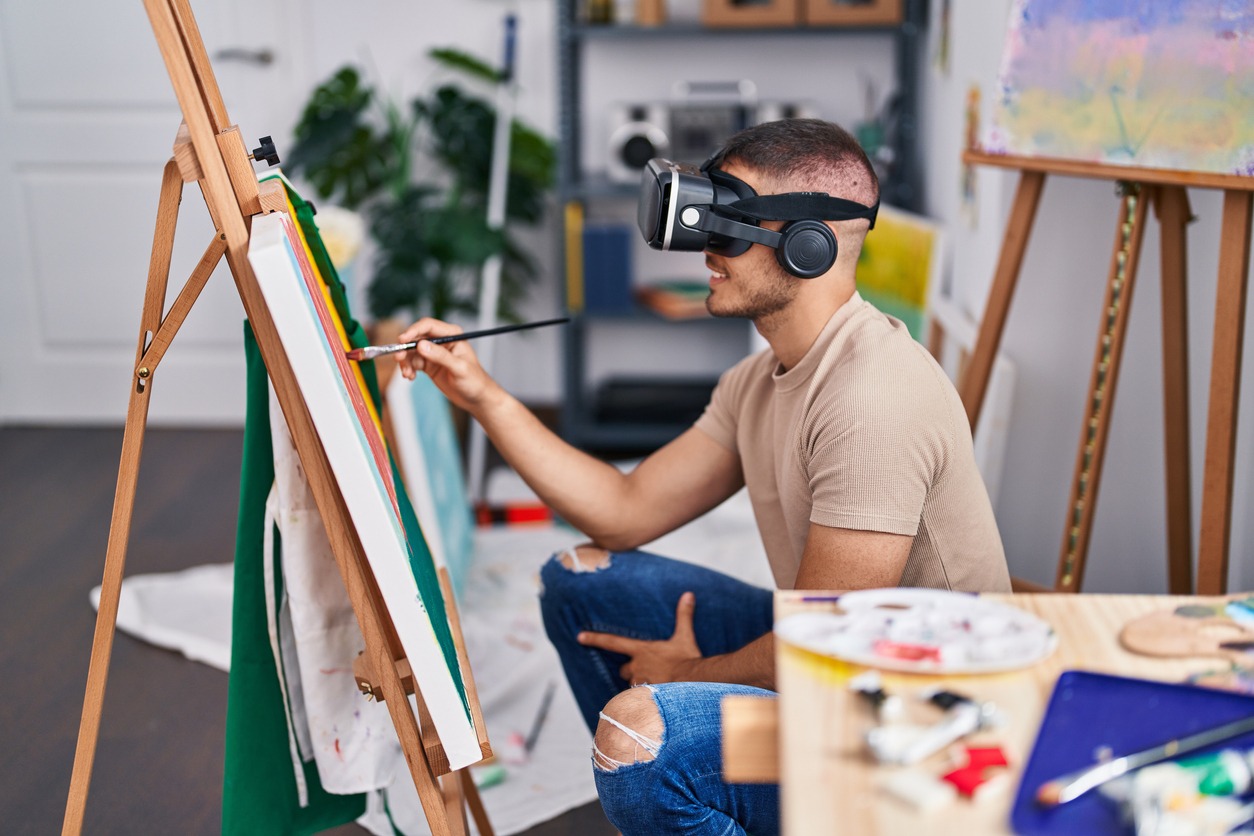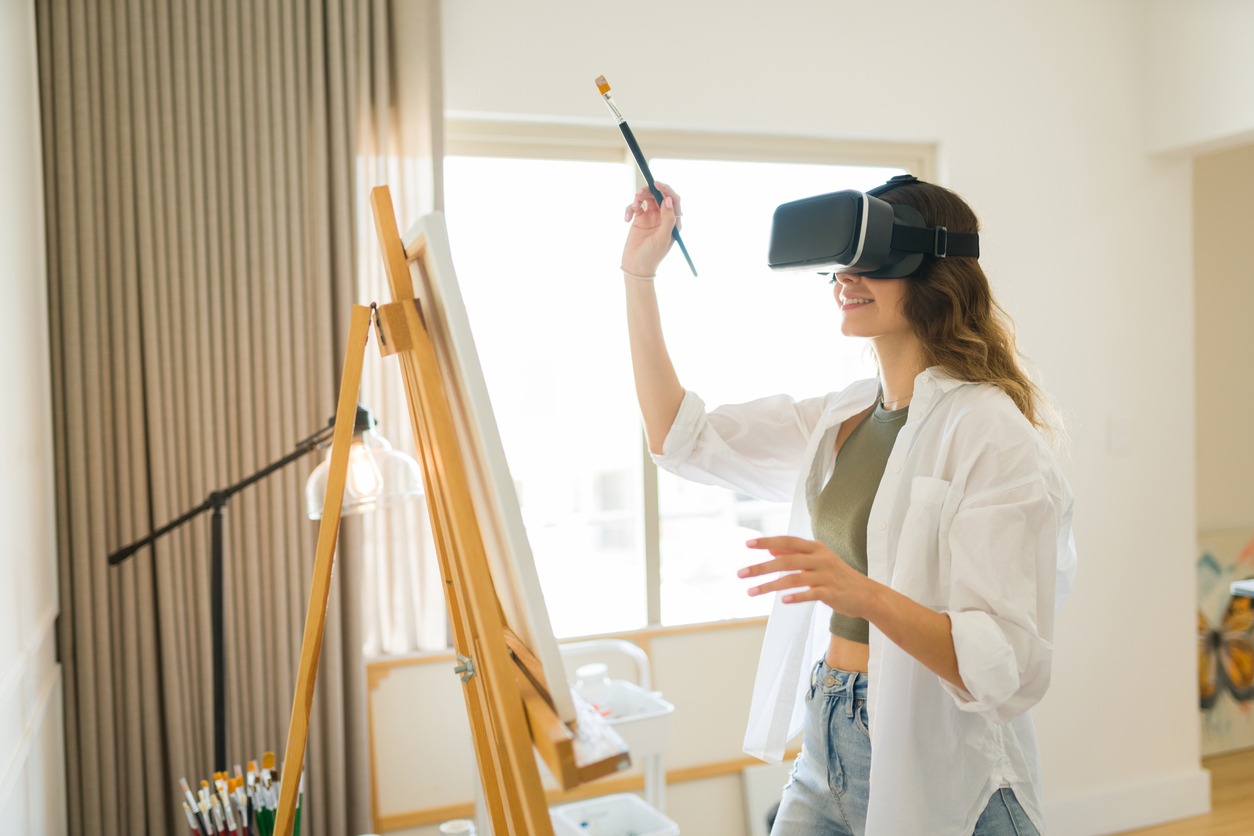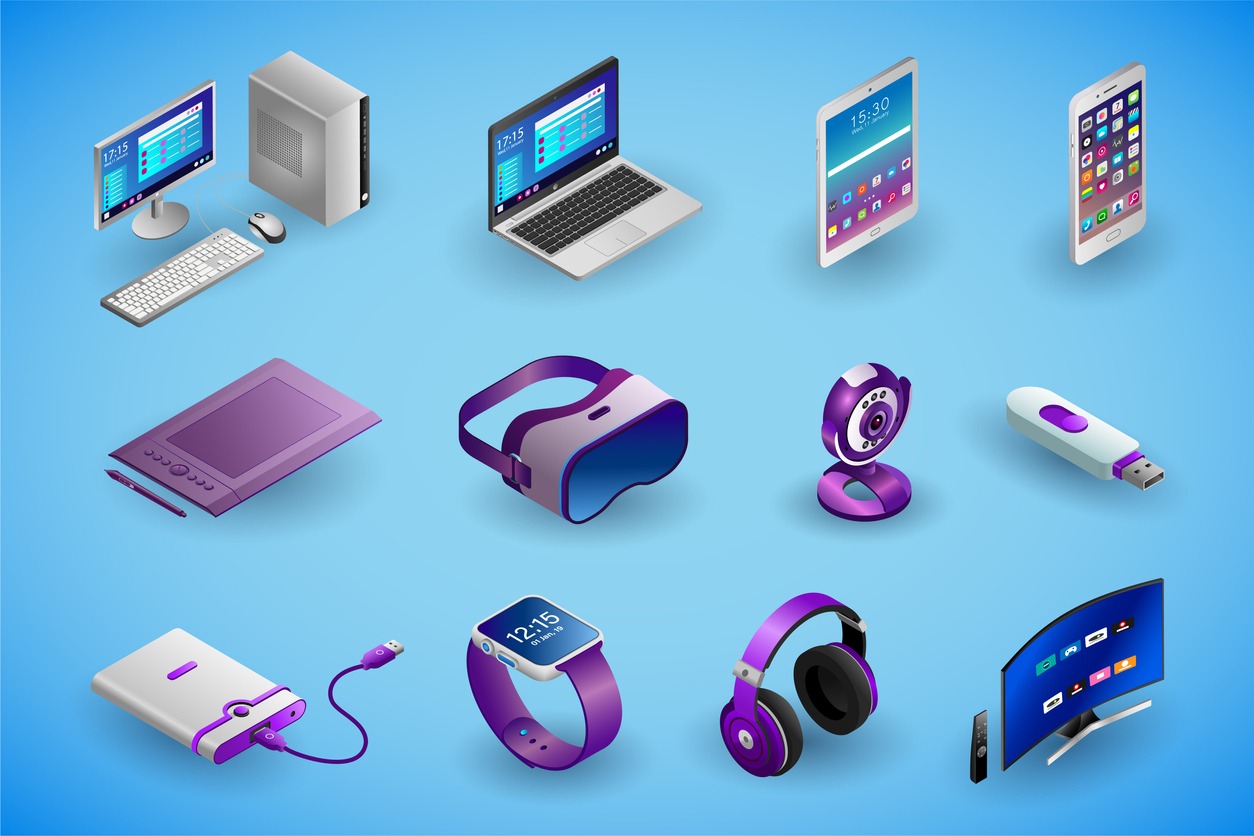While gaming has been the most prominent use for virtual reality (VR), its potential extends far beyond that. Artists use VR for various creative pursuits, including painting, drawing, 3D modeling, sculpting, and animation. Whether you’re an illustrator, painter, architect, or any other creative visionary – VR offers a limitless canvas. It can take the form of a street mural, a three-dimensional sculpture, a runway show at Fashion Week, or even a stage set for Broadway. The popularity of VR headsets is on the rise, making it clear that this trend is here to stay.
Virtual reality has transformed the way we create and experience art, offering an immersive and interactive platform that breaks free from conventional artistic boundaries. More artists are now using VR for a wide range of creative pursuits, one of which is painting.
With VR art applications, artists can step into a new dimension where their imagination springs to life in vibrant colors and dynamic forms. VR encourages artists (and those who would like to be artists) to play with colors and tools on an almost boundless canvas.
In this article, we’ll help you navigate the exciting realm of virtual reality painting.
What is Virtual Reality Painting?
VR painting can seem too techy for beginners, but it’s actually fairly straightforward. Virtual reality painting, also known as VR painting, is a form of digital art that uses virtual reality technology to create 3D and immersive painting experiences. In VR painting, artists use specialized VR hardware, such as VR headsets and motion controllers, to create artwork within a virtual environment.
Unlike traditional art forms like painting or photography, VR art places the audience inside the artwork, immersing them in a 3D environment where they can observe and interact with the art. While this deep level of immersion quickly captures attention, it presents challenges in directing that attention. Unlike a painting, photo, or movie, which can use frames or screens to guide the viewer’s focus, VR creators employ spatial audio, haptic feedback, and other techniques to engage and direct users.
VR offers an undistracted, immersive experience. As a creator, you have the user’s full attention, so make the most of it. In VR, you can do the impossible – defy the laws of physics, change perspectives, and create objects that appear or vanish based on where the user looks. You can even transform the user’s size in relation to the virtual world.
How VR Enhances the Painting Experience
Virtual reality art apps offer an incredible level of immersion, taking artists into a virtual realm where the line between artist and creation blurs. This results in a deeply engaging and transformative painting adventure.
- Interactivity and tactility: Thanks to motion controllers, artists can physically interact with their artwork, allowing them to mimic traditional painting and sculpting techniques. The sense of touch and natural manipulation of virtual objects enriches the tactile experience.
- Distraction-free environment: VR painting isolates you from the physical world, creating a focused and immersive space where artists can enter a state of flow. This deep connection with their art allows creativity to flourish.
- Realistic materials and textures: VR art apps replicate real-world materials, enabling artists to experiment with various brushes and tools. These apps provide a wide range of digital brushes, materials, and tools that simulate real-world painting and sculpting tools. Artists can choose from various brushes, textures, and colors to create their art.
- Exploring from every angle: The immersive perspective lets artists view their creations from different angles, walk around them, and even step inside. It provides users a unique understanding of composition, depth, and perspective.
- Collaboration: Some VR painting platforms enable multiple users to collaborate in the same virtual space, making it possible for artists to work together on a single piece or to showcase their work in a shared VR gallery.
- Undo/redo and experimentation: VR painting applications often provide the ability to undo or redo actions, which allows artists to experiment and make changes easily. This feature encourages creative exploration.
- Exporting and sharing: Artists can export their VR paintings as digital files or even 3D models, making it possible to share their work online or 3D print their creations for physical display.
How to Create a Virtual Reality Art Piece
If you’re eager to embark on a VR art journey, here are the steps you need to take:
Step 1: Get the Right Equipment
To dabble in virtual reality painting, you need the proper tools to give you a great experience. Here’s what you need to start VR painting:
1. PC
Starting with a VR-ready PC is your best bet for creating or gaming in virtual reality. VR is quite demanding on your computer, as it needs to generate separate images for each eye at a high frame rate and resolution. A top-notch video card, like the GTX 1080 Ti, is essential to ensure a smooth VR experience running at 90 frames per second. Investing in quality PC components will pay off in the long run, and you can always upgrade parts as needed. Make sure you have enough physical space in your studio or room for VR activities so you can move freely.
2. VR Headset
There are numerous options to choose from. If you’re ready to make the investment, consider popular VR headsets like the Oculus Quest 2, Sony PlayStation VR, or HTC Vive Cosmos.
If you’re not quite ready for a high-cost VR setup, you can dip your toes into the virtual waters with more budget-friendly options like Art Vision VR smartphone glasses or Google Cardboard. These budget alternatives allow you to explore 360-degree photos and VR videos on YouTube, even though they might not support most VR games.
Before you make a decision, it’s a good idea to read user reviews online to find the best fit for your specific needs. For example, if you’re considering an Art Vision virtual reality headset, some reviews indicate that while it offers access to 3D media, it lacks an interaction button and may require additional purchases like a Bluetooth controller for an optimal experience.
Before buying a VR HMD, try the headsets at events or in stores and spend time in different scenarios. Paint in Tilt Brush for a few minutes and engage in something fast-paced like Beat Saber. While wearing the headset, make sure you can adjust it to the shape of your head. If you wear glasses, check if they fit comfortably inside the headset, or consider looking for suitable add-ons.
In the end, the choice of headset that feels right or the least uncomfortable on your face should be the one you go for. Remember that you might lose track of time while creating art in Virtual Reality, so comfort is crucial when selecting a VR HMD for your art endeavors if you plan to spend a significant amount of time painting.
Step 2: Familiarize Yourself with the VR Experience
Spending time in virtual reality not only helps you understand the user perspective but can also inspire creative ideas for your projects. Becoming acquainted with VR also involves learning how to use it safely. Make sure you have a designated, obstacle-free space before putting on your headset. It’s a good idea to limit your initial sessions to 20-30 minutes until you understand how your body reacts to virtual reality.
Step 3: Download or Get the Software That Matches Your Artistic Vision
The good news is that many of the tools for creating virtual reality art are either free or have free versions available. Some apps and design tools are quite affordable, making them accessible for artists on a budget.
-
Tilt Brush
Tilt Brush is one of the most accessible VR painting experiences. It takes paintbrush strokes into 3D space, creating stunning effects. Novices can opt for the beginner mode, and it has a thriving community of artists for learning and inspiration.
-
Open Brush
Open Brush is the successor to Tilt Brush, a 3D-painting VR application. It allows you to paint in 3D space, offering a wide range of brushes, including stars, light, and fire. Your room becomes your canvas, and your imagination is your palette.
-
Quill
Quill is an illustration and animation tool designed for artists, designers, and storytellers. You can create fully animated VR films or produce traditional 3D or 2D artwork and game assets. It’s known for its expressive and precise features, allowing the artist’s unique style to shine through.
- Painting VR
Painting VR is one of the latest VR painting games, providing a straightforward canvas-and-paint experience with finely tuned brushstrokes and realistic color blending. It allows you to unleash your artistic skills with complete freedom without the need to tidy up afterward.
-
Kingspray Graffiti
Kingspray Graffiti offers a genuine street art experience in VR. It features realistic spray paint effects, vibrant colors, and a gritty city environment. You can paint solo or collaborate with others to create vibrant street art together.
-
Vermillion
Vermillion offers a unique fusion of oil painting and music. It lets you create vibrant visual compositions synchronized with music, opening up new dimensions of artistic expression. With its user-friendly interface and powerful tools, Vermillion allows artists to paint, animate, and visualize sound in impressive ways. You can learn from your favorite YouTube artists using the built-in web browser, trace reference images on the canvas, and even collaborate with friends in multiplayer.
-
Brushwork VR
Designed specifically for VR painting, Brushwork VR offers an interface that makes digital painting feel like a natural extension of your artistic abilities. It features a wide range of traditional and experimental brushes to help artists create beautiful strokes and textures on a virtual canvas.
-
Art Studio VR
Art Studio VR provides various brushes, pencils, and artistic tools with customizable settings to match your preferred style. It also offers a selection of environments and backdrops, allowing you to create immersive scenes and explore different moods in your artwork.
Step 4: Delve into the World of 3D Design
Just like mastering the fundamentals is crucial in 2D art, 3D design has its own learning curve. Depending on your projects and goals, you’ll want to invest time in understanding 3D lighting, texture simulation, virtual 3D sculpting, and other techniques to breathe life into your VR scenes.
Step 5: Elevate Your Creations
Virtual reality empowers artists to transform ordinary scenes into extraordinary destinations. If your initial forays into VR art don’t meet your expectations, don’t be disheartened. Like any artistic pursuit, practice makes perfect.
Once you’ve got the basics down, consider exploring advanced platforms like Quill for animation and illustration, Unbound Alpha, and Oculus Medium for crafting 3D sculptures. You might also find your creative interests expanding into other mixed reality art forms like augmented reality (AR).
With a bit of patience and guidance from experienced Skillshare instructors, you can experience the joy of taking your art from traditional pages, canvases, and 2D screens into the immersive realm of virtual reality.
Benefits and Challenges of VR Art vs. Traditional Media
Virtual reality offers a unique canvas for artistic expression, but how does it stack up against traditional media like canvas, clay, or paper? Let’s delve into the benefits and challenges of creating art in VR compared to traditional methods.
Benefits:
1. Boundless freedom
One standout advantage of VR art is the boundless freedom it grants. VR breaks free from physical limitations, allowing artists to create without size, shape, or material constraints. The possibilities are endless, from crafting lifelike landscapes to abstract sculptures and from intricate details to grand scales. VR also encourages experimentation with styles, colors, textures, and effects, all while providing the ease of undoing or redoing actions. In VR, artists have the canvas to explore fresh and innovative forms of self-expression. Whereas in traditional painting, a painter is limited by the materials they have on hand.
2. Interactivity and immersion
VR art immerses creators in their own masterpieces, fostering interaction and engagement. Artists can move about, touch, and manipulate their works, and explore different angles and perspectives. Sharing these creations becomes a social experience, as others can join virtual galleries or studios. It enables collaboration and appreciation in a more engaging and connected way.
3. Learning and accessibility
VR serves as a powerful tool for learning and skill improvement. Artists can gain access to a wealth of tutorials, guides, and online resources, and learn from peers and experts. It offers an intuitive and interactive platform for honing techniques such as perspective, proportion, shading, and composition. Moreover, VR makes art more inclusive and accessible – breaking down barriers for those facing challenges in traditional media due to physical disabilities, space constraints, or financial limitations.
4. Real-time interaction
VR allows artists to use natural gestures and movements to sculpt, paint, and create while mimicking real-world actions. VR art tools often provide real-time interaction with the artwork, allowing artists to directly manipulate objects, textures, and lighting in the virtual space
Challenges:
1.Technical Challenges
VR art may come with technical and ergonomic issues related to your VR headset and controllers. You could face issues like low resolution, latency, glitches, or compatibility problems between hardware and software.
2.Ergonomic Challenges
Prolonged use of VR might lead to discomfort, fatigue, eye strain, or even motion sickness. To alleviate these problems, adjustments, regular breaks, and device calibrations may be necessary.
3.Quality Issues
In VR, achieving the desired quality for your art can be challenging. Unlike traditional media, where you can physically touch, feel, and inspect your creations – VR artworks remain confined to the virtual realm. Capturing the same level of detail, texture, or realism can be challenging.
4.Learning Curve
Learning to use VR art tools and software can be complex. It requires artists to first become proficient in this medium before they can experiment and make art.
5.Costly
VR art typically demands specialized, costly hardware like a VR headset and a powerful computer, which may be financially out of reach for some artists. Also, the market for VR art is still emerging, which means it may not be as extensive or financially rewarding as more established traditional art forms.
6.Sharing and Feedback Limitations
Sometimes, it may be difficult to share, explore or print VR artwork. Constructive criticism and recognition from others might also be limited because not all people that you want to view your art use VR. Furthermore, while VR can offer collaboration, it may also feel isolating, as artists might miss traditional art creation’s tactile and social aspects.
7.Ethical and Legal Considerations
Creating art in VR introduces ethical and legal implications to be mindful of. Issues like copyright, ownership, and attribution become relevant, especially when sharing your work online or using it for commercial purposes. It is crucial to respect the privacy, consent and rights of others, particularly in collaborative or interactive VR settings. Adhering to the guidelines and rules of the VR platforms and communities you engage with is also important.
Despite these challenges, many artists find VR art’s unique possibilities and creative freedom worth the effort.
Conclusion
VR painting apps provide artists with a gateway to break free from the limitations of traditional media and enter a world where their creative visions can spring to life in three dimensions. With VR, you can manipulate virtual materials, play with an array of colors and textures, and collaborate with fellow artists in virtual realms. If you’re looking to try something new, it’s time to expand your canvas beyond the physical world and embrace the limitless possibilities of virtual reality art. If you’re interested in other ways to have fun with VR, you may want to check out some VR games that let you feel like you’re flying!


